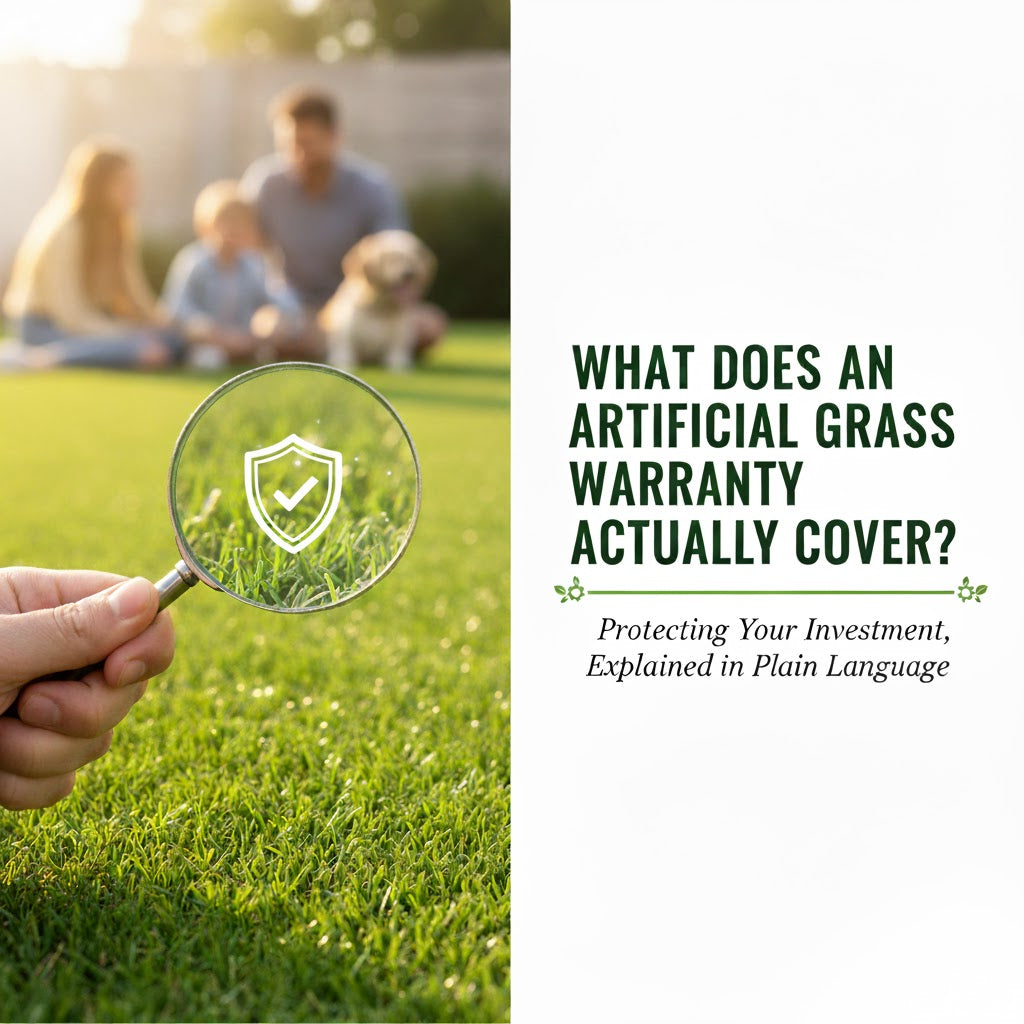You’ve spent good money to make your yard look green and clean all year. Artificial grass gives you that perfect look without mowing or watering. It’s a long-term investment, not a weekend project.
But like any big purchase, it needs protection. Things can fade, seams can lift, or the surface can wear out faster than you expected. That’s where a good artificial grass warranty steps in.
A warranty isn’t just a piece of paper. It’s a promise that your turf will hold up as it should, and if it doesn’t, the company will make it right. Still, not every warranty is the same. Some cover real problems, others are full of fine print.
This guide breaks it all down in plain language. You’ll learn what a warranty truly covers, what it doesn’t, and how to spot one that’s worth trusting.
Why Warranties Matter: Risks and Benefits
Artificial turf looks great and lasts for years when it’s made and installed right. But if something goes wrong, the repair costs can surprise you. That’s when a warranty saves you.
A strong artificial grass warranty protects you from paying for defects or early damage. It also shows that the manufacturer believes in their product. A company that offers a solid warranty is usually one that makes quality turf.
Without a warranty, any problem becomes your problem. If the grass fades, the seams separate, or the backing breaks down, you could end up replacing sections yourself. That can cost hundreds, sometimes thousands.
At PetGrow, we stand behind our artificial turf with a strong manufacturer warranty. We’ll show you how it compares to labor warranties, so you know exactly what is covered

What Typical Artificial Grass Warranties Cover
A good artificial grass warranty tells you what problems the company will fix. Most cover issues that happen because of how the turf was made, not how it was used.
Here are the main things usually included:
1. Material defects
This means problems in how the turf was built. It could be weak stitching, loose backing, or yarn that pulls apart too soon.
2. Color fading
Sunlight can cause turf to fade over time. Warranties often promise that normal sunlight will not cause major fading because of UV stabilizers used in the turf.
3. Premature wear
Turf should handle everyday use without breaking down fast. If it wears out sooner than expected, it may be covered.
4. Backing or bonding issues
Sometimes, the layers that hold the grass together can separate. Most warranties list this as a covered defect.
What Warranties Don’t Cover
Every artificial grass warranty has limits. It’s important to know what is not included before you buy. That way, you won’t be caught off guard later.
Here are the most common exclusions:
1. Heat or glare damage
Reflections from windows or metal surfaces can melt turf fibers. Most companies do not cover this kind of damage.
2. Improper installation
If the base wasn’t prepared right or seams weren’t joined well, the problem falls under the installer, not the manufacturer.
3. Misuse or neglect
Heavy furniture, pet digging, or not cleaning debris can damage turf. These are not covered.
4. Natural wear and tear
Over time, turf will flatten or lose some color. This normal aging is not a defect.
5. Acts of nature
Floods, fire, or earthquakes are usually excluded from any warranty.
6. Lack of maintenance
Skipping regular brushing or ignoring cleaning rules can void your warranty.

Types of Warranties
Not every artificial grass warranty means the same thing. Two main types usually come with a turf project — a manufacturer warranty and an installation or labor warranty. Understanding both helps you know who to contact if your turf ever has a problem.
1. Manufacturer Warranty
A manufacturer warranty covers the turf product itself. It protects you against problems caused by how the turf was made, not how it was installed or used. This includes material defects, color fading, and backing separation.
For example, if the turf fibers start breaking down too soon, or the color fades unevenly even though you maintained it properly, the manufacturer is responsible for repairs or replacement. Most warranties also promise that the turf will resist UV rays thanks to built-in stabilizers.
These warranties often last between 8 and 15 years, depending on the brand and product quality. Some premium turf brands offer extended or even “lifetime” warranties, but it’s important to read the fine print. Many long warranties are prorated, meaning the coverage decreases as the turf gets older. For instance, full coverage may apply for the first 8 years, then drop to partial coverage later.
A manufacturer warranty usually covers only the product. It does not include labor, removal, or reinstallation costs. If the company replaces a section of turf, you may still need to pay someone to remove the damaged part and reinstall the new one.
2. Installation or Labor Warranty
The installation warranty is different. It comes from the installer or contractor, not the manufacturer. This warranty focuses on how well the turf was installed. It covers problems such as seam separation, wrinkles, poor drainage, or uneven surfaces that appear after installation.
Labor warranties are shorter, usually one to three years, because installation issues tend to show up early. If the turf shifts, lifts, or wrinkles within that time, the installer should fix it at no cost to you.
Reading the Fine Print
Before you sign or buy, take time to read every line of your artificial grass warranty. The small print explains what you really get, not just what the ad says.
1. Proration schedule
Many warranties lose value over time. For example, the first few years may be covered 100 percent, but later years might only cover part of the cost.
2. Transferability
Some warranties end when you sell your home. Others can be transferred to the new owner. A transferable warranty can help if you plan to move.
3. Claim rules
Most companies ask for photos, receipts, and proof of installation. You also need to report problems within a certain time, often 30 days.
4. Limited remedy
Most warranties promise to repair or replace only the damaged section, not the whole lawn. They also rarely pay for labor or shipping.
5. Maintenance terms
If the warranty requires cleaning or brushing on schedule, you must follow those rules to stay covered.
How to Evaluate and Compare Warranties
When comparing turf brands, don’t just look at price or appearance. Read the artificial grass warranty like you would any major contract. It tells you how much support you’ll get later.
Here’s a simple checklist to guide you:
1. Length and value
A 15-year warranty sounds great, but check if it’s prorated. You may only get partial coverage after a few years.
2. What’s covered
Look for protection against material defects, UV fading, and backing separation. The more specific the wording, the better.
3. What’s excluded
Check for exclusions such as heat damage, pet wear, or poor installation. Clear exclusions show honest terms.
4. Claim process
A good warranty explains how to file a claim, what proof you need, and how long it takes to get help.
5. Transferability
If you might sell your home, a transferable warranty adds value to your property.
6. Company reputation
Choose a brand or installer that has been around for years. A warranty only matters if the company stays in business.
7. Customer service
Responsive support makes claims faster and easier. Test their service with a quick call or email before buying.

Tips to Protect and Maintain Your Warranty
A good artificial grass warranty only works if you keep it valid. Many people lose coverage because they skip simple steps. Here’s how to protect yours.
1. Register your warranty
Most companies require you to register within 30 to 60 days after installation. Keep a copy of the confirmation for your records.
2. Follow maintenance rules
Brush your turf often to keep the fibers upright. Remove debris, rinse spills, and replace infill when needed. These small habits help your lawn last longer.
3. Keep records
Save receipts, photos, and notes of all maintenance. If you file a claim, these prove you cared for your turf properly.
4. Watch for early signs of trouble
Report issues such as fading, seam lifting, or wrinkling right away. Waiting too long may void your warranty.
5. Avoid actions that cause damage
Don’t drag heavy items, use harsh cleaners, or expose the turf to high heat or window glare. Most warranties exclude this type of damage.
Conclusion and Next Steps
An artificial grass warranty protects more than just turf. It protects your investment and peace of mind.
The best warranties cover defects, fading, and wear. They explain what’s excluded and tell you exactly how to file a claim. The weaker ones sound good but hide limits in small print.
Before you buy, read the warranty word by word. Ask your installer to explain any confusing parts. Compare how different brands handle proration, transfer rules, and repair options.
Want peace of mind? Check out PetGrow’s turf lines now. Request your warranty terms, get a sample, and see how our product and service back up your investment.


Share:
Exploring Popular Uses for Artificial Grass in Everyday Spaces
How to choose the best artificial grass for dogs? A complete guide